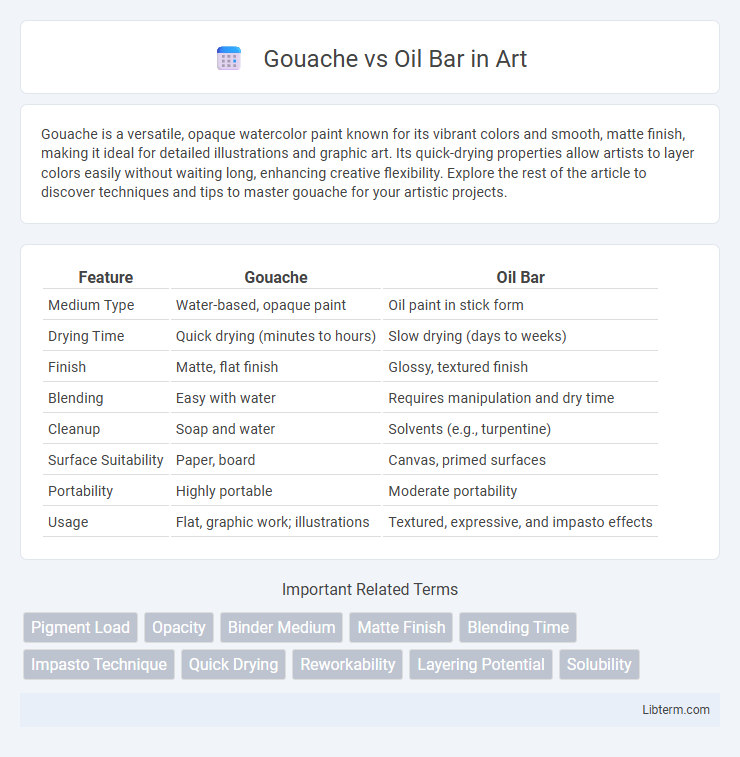Gouache is a versatile, opaque watercolor paint known for its vibrant colors and smooth, matte finish, making it ideal for detailed illustrations and graphic art. Its quick-drying properties allow artists to layer colors easily without waiting long, enhancing creative flexibility. Explore the rest of the article to discover techniques and tips to master gouache for your artistic projects.
Table of Comparison
| Feature | Gouache | Oil Bar |
|---|---|---|
| Medium Type | Water-based, opaque paint | Oil paint in stick form |
| Drying Time | Quick drying (minutes to hours) | Slow drying (days to weeks) |
| Finish | Matte, flat finish | Glossy, textured finish |
| Blending | Easy with water | Requires manipulation and dry time |
| Cleanup | Soap and water | Solvents (e.g., turpentine) |
| Surface Suitability | Paper, board | Canvas, primed surfaces |
| Portability | Highly portable | Moderate portability |
| Usage | Flat, graphic work; illustrations | Textured, expressive, and impasto effects |
Introduction to Gouache and Oil Bars
Gouache is an opaque watercolor paint known for its vibrant pigmentation and matte finish, offering artists versatility in layering and blending with quick drying times. Oil bars combine the rich texture and slow drying properties of traditional oil paints with the convenience of a crayon form, allowing for direct application and immediate manipulation on canvas. Both gouache and oil bars provide unique tactile experiences, catering to different artistic techniques and styles.
Key Differences Between Gouache and Oil Bars
Gouache is a water-based paint known for its opaque, matte finish and fast drying time, making it ideal for detailed illustrations and vibrant flat color fields. Oil bars combine traditional oil paint with a buttery consistency in stick form, offering rich, blendable textures and a slow drying process that supports extended working time and layering. The key differences lie in their mediums, drying times, finish, and handling techniques, with gouache favoring quick, precise applications and oil bars enabling expressive, tactile manipulation.
Composition and Ingredients
Gouache consists of pigment, water, and a binding agent such as gum arabic, creating a matte, opaque finish that dries quickly and allows for easy layering. Oil bars combine traditional oil paint ingredients--pigment, linseed oil, and wax--to form a solid stick with a buttery texture that retains the rich, glossy qualities of oil paint. The distinct formulations influence drying times, texture, and blending capabilities, with gouache offering vibrant, flat color and oil bars enabling smooth, textured strokes.
Color Vibrancy and Finish
Gouache offers vivid, matte color vibrancy with a smooth, opaque finish that dries quickly and allows for easy layering and reworking. Oil bars provide rich, intense hues with a glossy, textured finish that maintains color brilliance over time due to their oil-binding medium. The choice between gouache and oil bars ultimately depends on the desired finish--matte and flat versus glossy and tactile--and the permanence of color in the artwork.
Application Techniques
Gouache offers versatility in application techniques, allowing for smooth, opaque layers that dry quickly and can be easily reworked with water, making it ideal for fine details and soft gradients. In contrast, oil bars provide a rich, buttery texture that can be applied thickly or blended directly on the canvas, enabling artists to create bold, textured strokes and impasto effects without the need for brushes. Mastering gouache techniques involves wet-on-wet and glazing methods, while oil bar application emphasizes layering, blending with fingers or palette knives, and extended drying times that support complex textural development.
Drying Time and Workability
Gouache dries rapidly, usually within 15 to 30 minutes, enabling quick layering and adjustments, making it ideal for artists who prefer fast workability and immediate results. Oil bars, composed of oil paint in stick form, have extended drying times often spanning several days to weeks, allowing for prolonged blending and manipulation on the canvas. The difference in drying time significantly influences workflow: gouache supports swift fixes and matte finishes, while oil bars offer rich texture and depth due to their slow curing process.
Surface Compatibility
Gouache offers excellent adhesion to paper, board, and canvas, thriving on porous, absorbent surfaces that enhance its vibrant matte finish. Oil bars, made of oil paint in stick form, work best on primed canvas or rigid surfaces like wood panels, where their oily texture can blend smoothly without penning through. Surface preparation is crucial for oil bars to prevent oil saturation and ensure proper drying, while gouache demands minimal prep due to its water-based formula.
Longevity and Durability
Gouache offers vibrant, matte finishes but is less durable due to its water-soluble nature, requiring protective framing to prevent moisture damage over time. Oil bars, composed of oil paint in stick form, provide superior longevity with their oil-based composition, resisting fading and cracking for decades. Artists seeking long-lasting, resilient artwork often prefer oil bars for their stable, age-resistant qualities.
Best Uses and Artistic Styles
Gouache excels in creating vibrant, matte finishes ideal for illustration, graphic design, and detailed work due to its quick-drying and opaque properties. Oil bars, combining oil paint with a stick form, offer rich textures and blending capabilities perfect for expressive, impasto-style painting and plein air landscapes. Artists seeking fine detail and layering typically prefer gouache, while those favoring bold, tactile effects often choose oil bars for contemporary and abstract styles.
Choosing the Right Medium for Your Art
Selecting between gouache and oil bars depends on your desired texture and drying time; gouache offers quick drying with matte, opaque finishes ideal for detailed work, while oil bars provide rich, blendable colors and a longer drying period suited for expressive, layered techniques. Consider the surface as gouache performs best on paper or illustration board, whereas oil bars are compatible with primed canvas or wood panels for enhanced durability. Your choice should align with your workflow preferences and the final look you aim to achieve in your artwork.
Gouache Infographic

 libterm.com
libterm.com